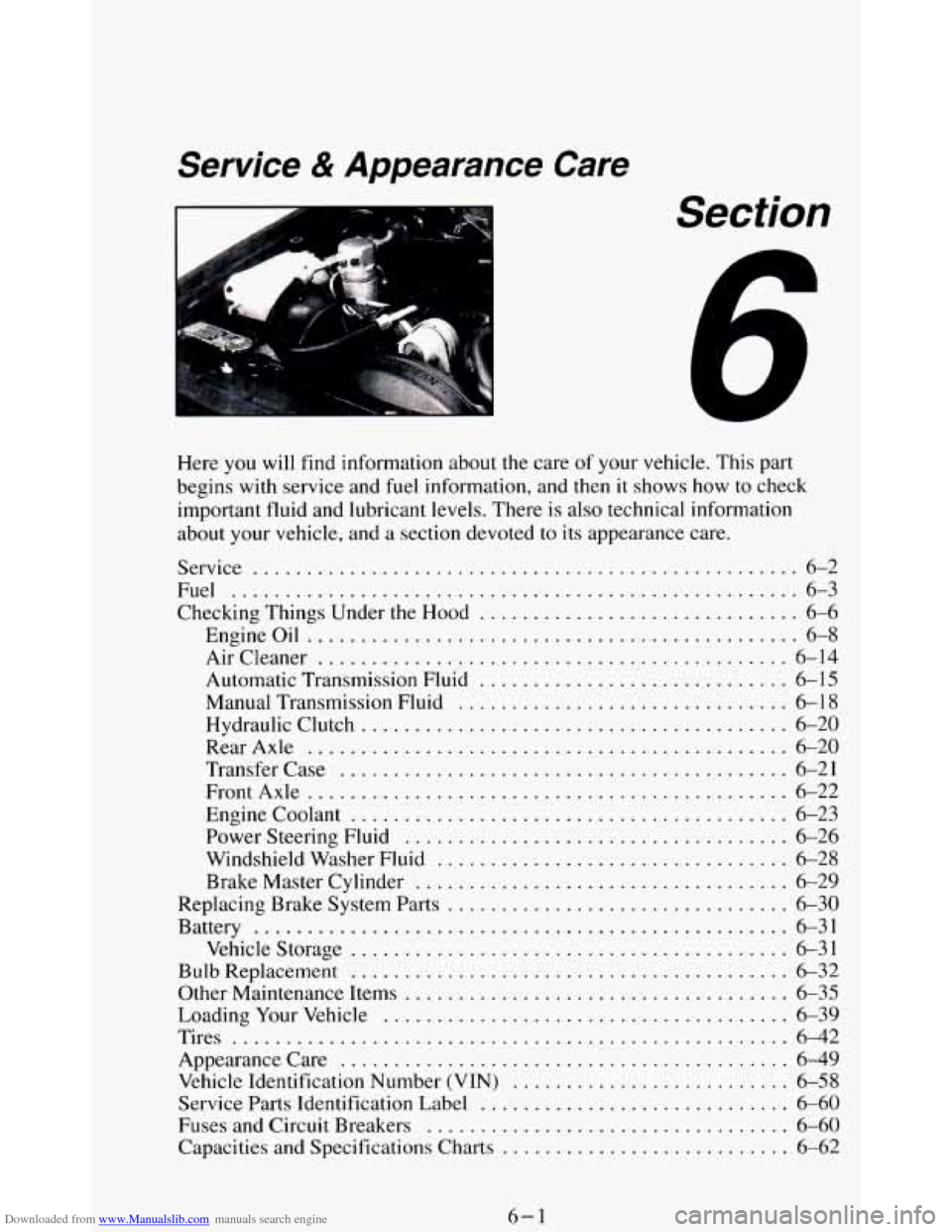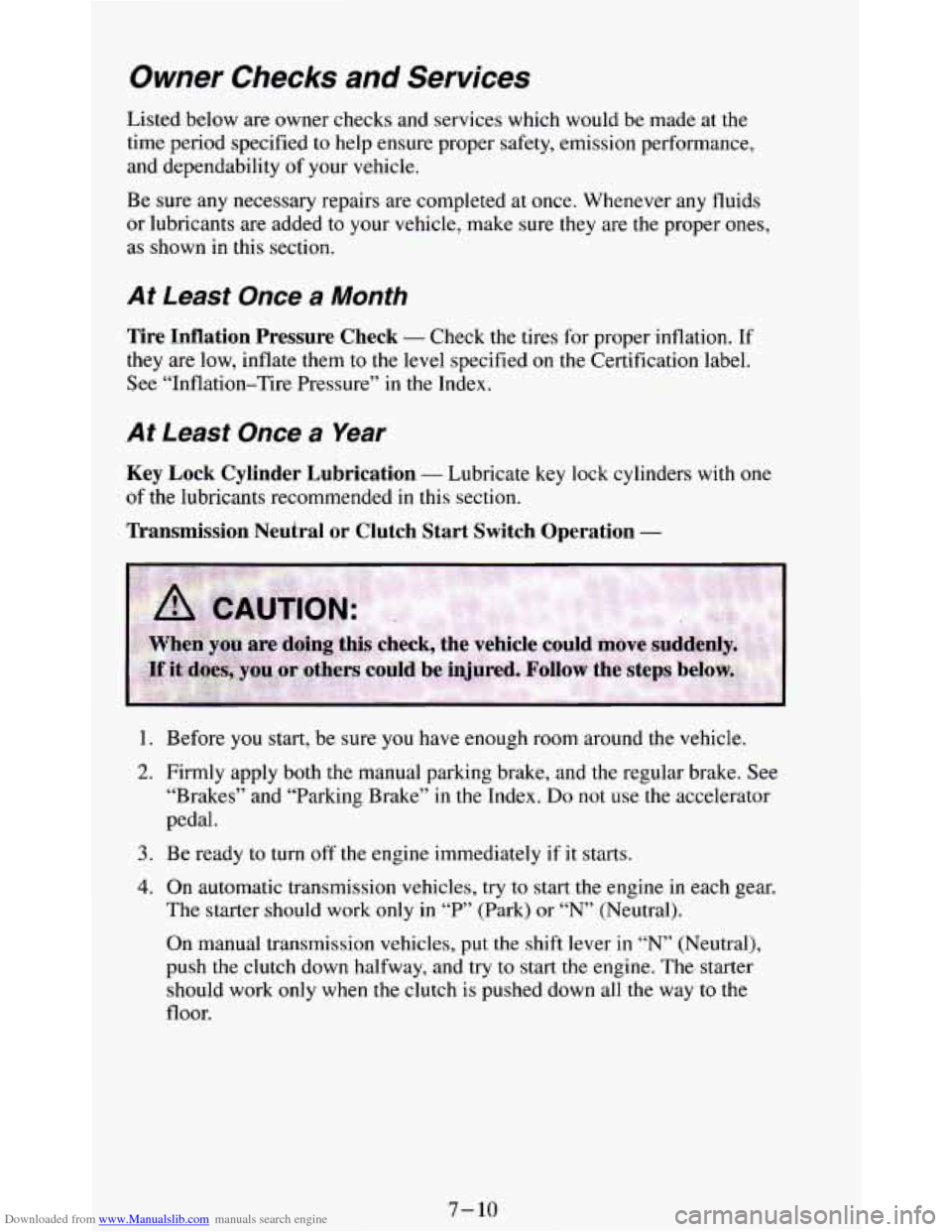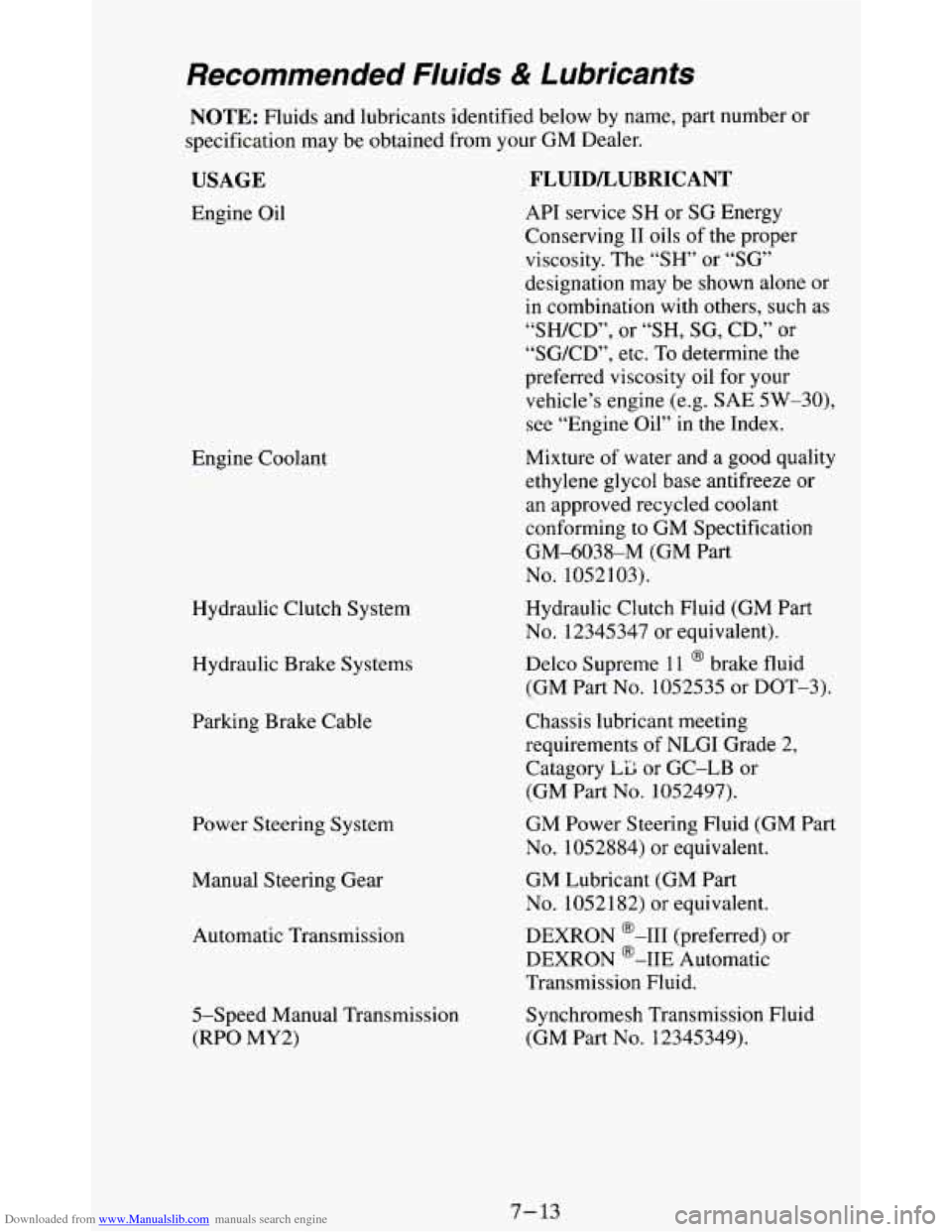1994 CHEVROLET BLAZER automatic transmission fluid
[x] Cancel search: automatic transmission fluidPage 202 of 348

Downloaded from www.Manualslib.com manuals search engine Maintenance When Trailer Towing
Your vehicle will need service more often when you’re pulling a trailer. See
the Maintenance Schedule for more on this. Things that are especially
important in trailer operation are automatic transmission fluid (don’t
overfill), engine oil, axle lubricant, belt, cooling system, and brake
adjustment. Each of these is covered
in this manual, and the Index will help
you find them quickly. If you’re trailering,
it’s a good idea to review these
sections before you start your trip.
Check periodically to see that
all hitch nuts and bolts are tight.
Trailer Light Wiring
See “Trailer Wiring Harness” in the Index.
Power Winches
If you wish to use a power winch on your vehicle, only use it when your
vehicle
is stationary or anchored.
! NOTICE:
~ When operating a power winch on your vehicle always leave the \
l transmission in the neutral position. Do not leave an automatic
transmission in
P (Park) or a manual transmission in gear or the
transmission may be damaged.
Use the regular brakes, set the parking brake or block the wheels to keep
your vehicle from rolling.
4-44
Page 237 of 348

Downloaded from www.Manualslib.com manuals search engine Service & Appearance Care
Section
Here you will find information about the care of your vehicle . This part
begins with service and fuel information. and then
it shows how to check
important fluid and lubricant levels
. There is also technical information
about your vehicle. and a section devoted to
its appearance care .
Service ................................................... 6-2
Fuel
..................................................... 6-3
Checking Things Under the Hood
.............................. 6-6
Engineoil
.............................................. 6-8
Aircleaner
............................................ 6-14
Automatic Transmission Fluid
............................. 6-15
Manual Transmission Fluid
............................... 6-18
Hydraulic Clutch ........................................ 6-20
RearAxle
............................................. 6-20
Transfer Case
.......................................... 6-21
FrontAxle
............................................. 6-22
Enginecoolant
......................................... 6-23
Power Steering Fluid
.................................... 6-26
Windshield Washer Fluid
................................. 6-28
Brake Master Cylinder
................................... 6-29
Replacing Brake System Parts
................................ 6-30
Battery
.................................................. 6-31
Vehiclestorage
......................................... 6-31
Bulb Replacement
......................................... 6-32
Other Maintenance Items
.................................... 6-35
Loading Your Vehicle
...................................... 6-39
Tires .................................................... 6-42
Appearance Care
.......................................... 6-49
Vehicle Identification Number (VIN)
.......................... 6-58
Service Parts Identification Label
............................. 6-60
Fuses and Circuit Breakers
.................................. 6-60
Capacities and Specifications Charts
........................... 6-62
6-1
Page 251 of 348

Downloaded from www.Manualslib.com manuals search engine NOTICE:
If the air cleaner is off, a backfire can cause a damaging engine
fire. And, dirt can easily get into your engine, which will damage
it. Always have the air cleaner in place when you’re driving.
Automatic Transmission Fluid
When to Check and Change
A good time to check your automatic transmission fluid level is when the
engine
oil is changed. Refer to the Maintenance Schedule to determine
when
to change your fluid. See “Scheduled Maintenance Services” in the
Index.
How to Check
Because this operation can be a little difficult, you may choose to have this
done at a
GM dealership Service Department.
If
you do it yourself, be sure to follow all the instructions here, or you could
get
a false reading on the dipstick.
NOTICE:
Too much or too little fluid can damage your transmission. Too
much can mean that some of the fluid could come out and fall on
hot engine parts or exhaust system, starting
a fire. Be sure to get
an accurate reading if you check your transmission fluid.
6-15
Page 254 of 348

Downloaded from www.Manualslib.com manuals search engine 4. If the fluid level
is in the
acceptable range,
push the dipstick
back in all the
way; then flip
the
handle down to
lock the dipstick
in place.
How to Add Fluid
Refer to the Maintenance Schedule to determine what kind of transmission
fluid to use. See “Recommended Fluids and Lubricants’’
in the Index.
If the fluid level is low, add only enough
of the proper fluid to bring the
level up to the
COLD area for a cold check or the HOT area for a hot check.
It doesn’t take much fluid, generally
less than a pint. Don’t overfill. We
recommend you use only fluids labeled DEXR0N’-I11 or DEXR0N’-IIE,
because fluids with those labels are made especially for your automatic
transmission. Damage caused by fluids other than DEXRON@-I11 or
DEXRON@-IIE
is not covered by your new vehicle warranty.
After adding fluid, recheck the fluid level as described under “How to
Check.”
When the correct fluid level is obtained, push the dipstick back in all
the way; then flip
the handle down to lock the dipstick in place.
Manual Transmission Fluid
When to Check
A good time to have it checked is when the engine oil is changed. However,
the fluid in your manual transmission doesn’t require changing.
How fo Check
Because this operation can be a little difficult, you may choose to have this
done at a
GM dealership Service Department.
If
you do it yourself, be sure to follow all the instructions here, or you could
get a false reading.
6- 18
Page 314 of 348

Downloaded from www.Manualslib.com manuals search engine 6.
7.
8.
9.
10. 11.
12.
TRANSMISSION SERVICE:
Automatic Transmission
- Change the transmission fluid and filter
every 15,000 miles
(25 000 km) if the vehicle is mainly driven under
one or more of these conditions:
In heavy city traffic.
Where the outside temperature regularly reaches 90°F (32” C) or
In hilly or mountainous terrain.
Frequent trailer pulling.
0 Uses such as taxi, police, delivery or other commercial service.
If the vehicle is not used mainly under any of these conditions, change
the fluid and filter
every 30,000 miles (50 000 km). See “Automatic
Transmission Fluid”
in the Index for more information.
Manual Transmission - Transmission fluid does not require periodic
changing.
FUEL FILTER REPLACEMENT* $- Replace the fuel filter at the
specified interval or sooner
if clogged.
SPARK PLUG REPLACEMENT* - Replace spark plugs with the
type listed in Section 6. See “Specification Charts” in the Index.
SPARK PLUG WIRE INSPECTION* - Clean wires and inspect
for burns, cracks or other damage. Check the wire boot fit
at the
distributor and at the spark plugs. Replace wires as needed.
ENGINE TIMING CHECK AND DISTRIBUTOR CHECK*$ -
Adjust timing to underhood label specifications. Inspect the inside and
outside of the distributor cap and rotor for cracks, carbon tracking and
corrosion. Clean or replace as needed.
FUEL TANK, CAP AND LINES INSPECTION*$ - Inspect the
fuel tank, cap and lines for damage
or leaks. Remove fuel cap, inspect
gasket for an even filler neck imprint, and any damage. Replace parts
as needed.
ENGINE ACCESSORY DRIVE BELT INSPECTION* - Inspect
belt. Look for cracks, fraying, wear, and proper tension. Adjust or
replace as needed.
higher.
*An Emission Control Service
$=The California Air Resources Board has determined that the failure to
perform this maintenance item will not nullify the emission warranty or
limit recall liability prior to the completion of vehicle useful life. General
Motors, however, urges that all recommended maintenance services be
performed at the indicated intervals and the maintenance be recorded.
7-8
Page 316 of 348

Downloaded from www.Manualslib.com manuals search engine Owner Checks and Services
Listed below are owner checks and services which would be made at the
time period specified to help ensure proper safety, emission performance,
and dependability of your vehicle.
Be sure any necessary repairs are completed at once. Whenever any fluids
or lubricants are added
to your vehicle, make sure they are the proper ones,
as shown in this section.
At Least Once a Month
Tire Inflation Pressure Check - Check the tires for proper inflation. If
they are low, inflate them to the level specified on the Certification label.
See “Inflation-Tire Pressure” in the Index.
At Least Once a Year
Key Lock Cylinder Lubrication - Lubricate key lock cylinders with one
of the lubricants recommended
in this section.
Transmission Neutral or Clutch Start Switch Operation -
1. Before you start, be sure you have enough room around the vehicle.
2. Firmly apply both the manual parking brake, and the regular brake. See
“Brakes” and “Parking Brake” in the Index.
Do not use the accelerator
pedal.
3. Be ready to turn off the engine immediately if it starts.
4. On automatic transmission vehicles, try to start the engine in each gear.
The starter should work
only in “P” (Park) or “N” (Neutral).
On manual transmission vehicles, put the shift lever in “N’ (Neutral),
push the clutch down halfway, and try to start the engine. The starter
should work only when the clutch is pushed down
all the way to the
floor.
7-10
Page 319 of 348

Downloaded from www.Manualslib.com manuals search engine Recommended Fluids & Lubricants
NOTE: Fluids and lubricants identified below by name, part number or
specification may be obtained from your GM Dealer.
USAGE
Engine Oil
Engine Coolant
Hydraulic Clutch System
Hydraulic Brake Systems
Parking Brake Cable Power Steering System
Manual Steering Gear
Automatic Transmission
5-Speed Manual Transmission
(RPO MY2)
FLUIDLUBRICANT
API service SH or SG Energy
Conserving
I1 oils of the proper
viscosity. The “SH” or
“SG’
designation may be shown alone or
in combination with others, such as
“SH/CD”, or “SH, SG, CD,”
or
“SG/CD”, etc. To determine the
preferred viscosity oil for your
vehicle’s engine (e.g.
SAE 5W-30),
see “Engine Oil”
in the Index.
Mixture of water and
a good quality
ethylene glycol base antifreeze or
an approved recycled coolant
conforming to GM Spectification
GM-6038-M (GM Part
No. 1052 103).
Hydraulic Clutch Fluid (GM Part
No. 12345347 or equivalent).
Delco Supreme
1 1 @ brake fluid
(GM Part No. 1052535 or DOT-3).
Chassis lubricant meeting
requirements
of NLGI Grade 2,
Catagory
LiIl or GC-LB or
(GM Part No. 1052497).
GM Power Steering Fluid (GM Part
No. 1052884) or equivalent.
GM Lubricant (GM Part
No. 1052182) or equivalent.
DEXRON
@-I11 (preferred) or
DEXRON @-IIE Automatic
Transmission Fluid.
Synchromesh Transmission Fluid
(GM Part
No. 12345349).
7- 13
Page 320 of 348

Downloaded from www.Manualslib.com manuals search engine USAGE
Differential:
a. Standard
- Front and Rear Axle
b. Locking
Transfer Case
Column Shift, Transfer Case Shift
Lever, Propeller Shaft Slip Splines
and Universal Joints.
Clutch Linkage. Pushrod to clutch
fork joint.
Hood Latch Assembly:
a. Pivots and spring anchor
b. Release Pawl
Front Wheel Bearings
Constant Velocity Universal Joint
Automatic Transmission Shift
Linkage, Floor Shift Linkage, Hood and Door Hinges, Body Door Hinge
Pins, Endgate hinge and Linkage,
Folding Seat, Fuel Door Hinge
Key Lock Cylinders
FLUIDLUBRICANT
a. SAE-SOW-90 GL-5 gear
lubricant (GM Part No. 1052271).
b. SAE-80W-90 gear lubricant or
(GM Part No. 1052271).
DEXRON@-IIE Automatic
Transmission Fluid (GM Part
No. 105 1855).
Chassis lubricant meeting
requirements of NLGI Grade 2,
Catagory LB or GC-LB
(GM Part
No. 1052497).
Chassis lubricant meeting
requirements of NLGI Grade 2,
Catagory LB or GC-LB (GM Part
No. 1052497).
a. Engine oil
(GM Part
No. 1050 109).
b. Chassis lubricant meeting
requirements of NLGI Grade
2,
Catagory LB (GM Part
No. 1052497)
or GC-LB or
equivalent.
Wheel bearing lubricant meeting
requirements of NLGI Grade 2,
Catagory GC or GC-LB (GM Part
No. 105 1344).
Chassis lubricant meeting
requirements of NLGI Grade 2,
Catagory
LB or GC-LB (GM Part
No. 1052497).
Engine Oil (GM Part
No. 1050109).
GM Multi-Purpose lubricant
(GM Part
No. 12345 120) or a
synthetic light weight engine oil
(S AE 5 W-30).
7-14